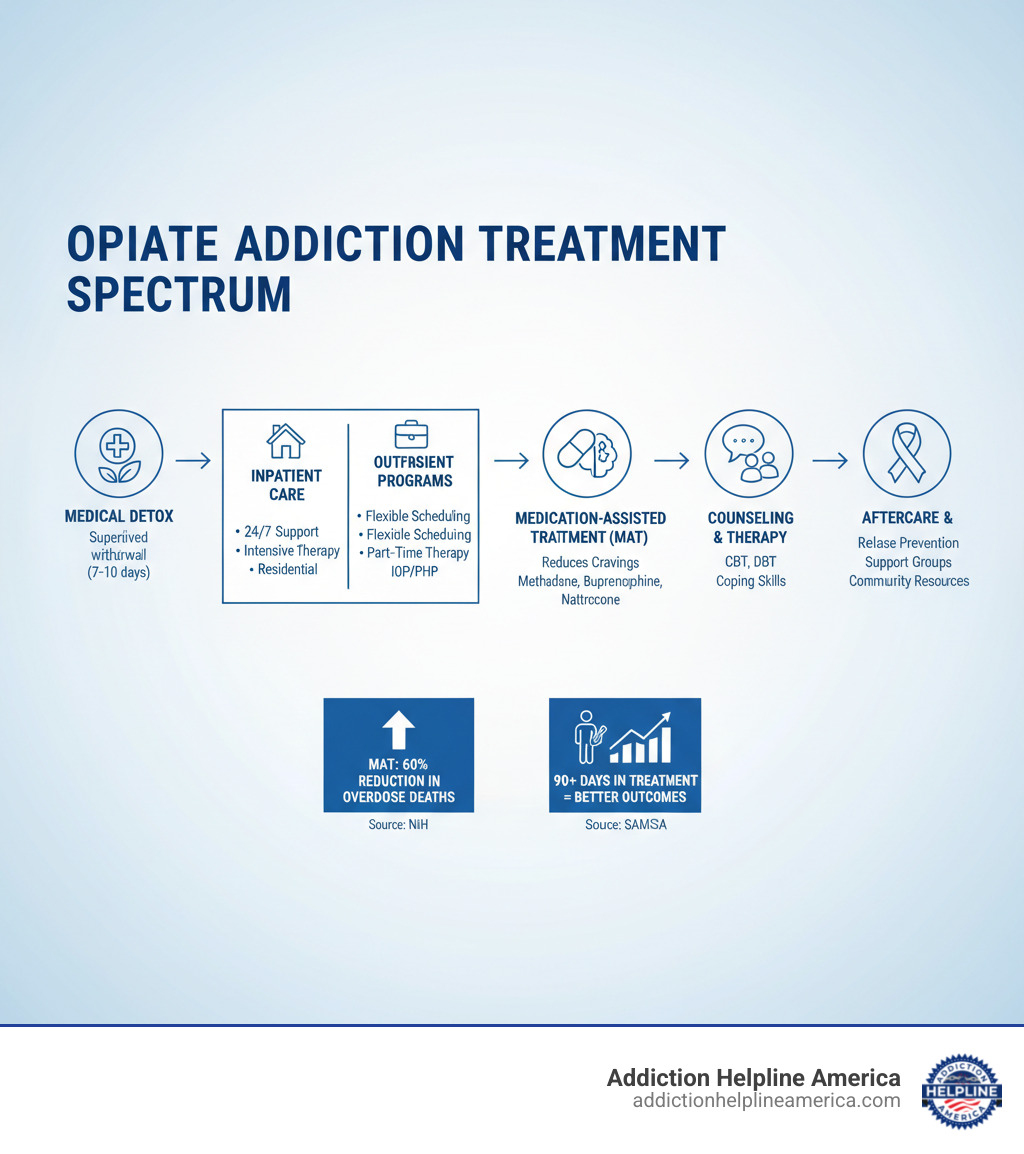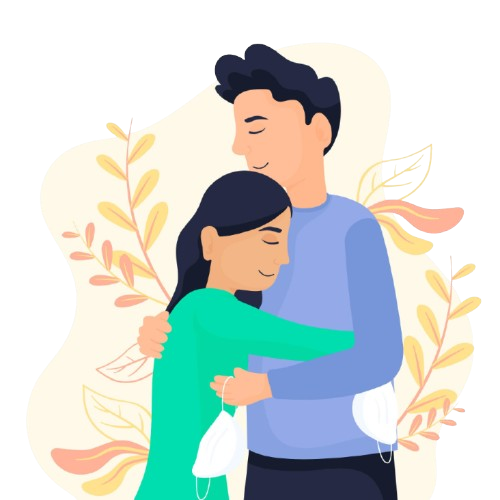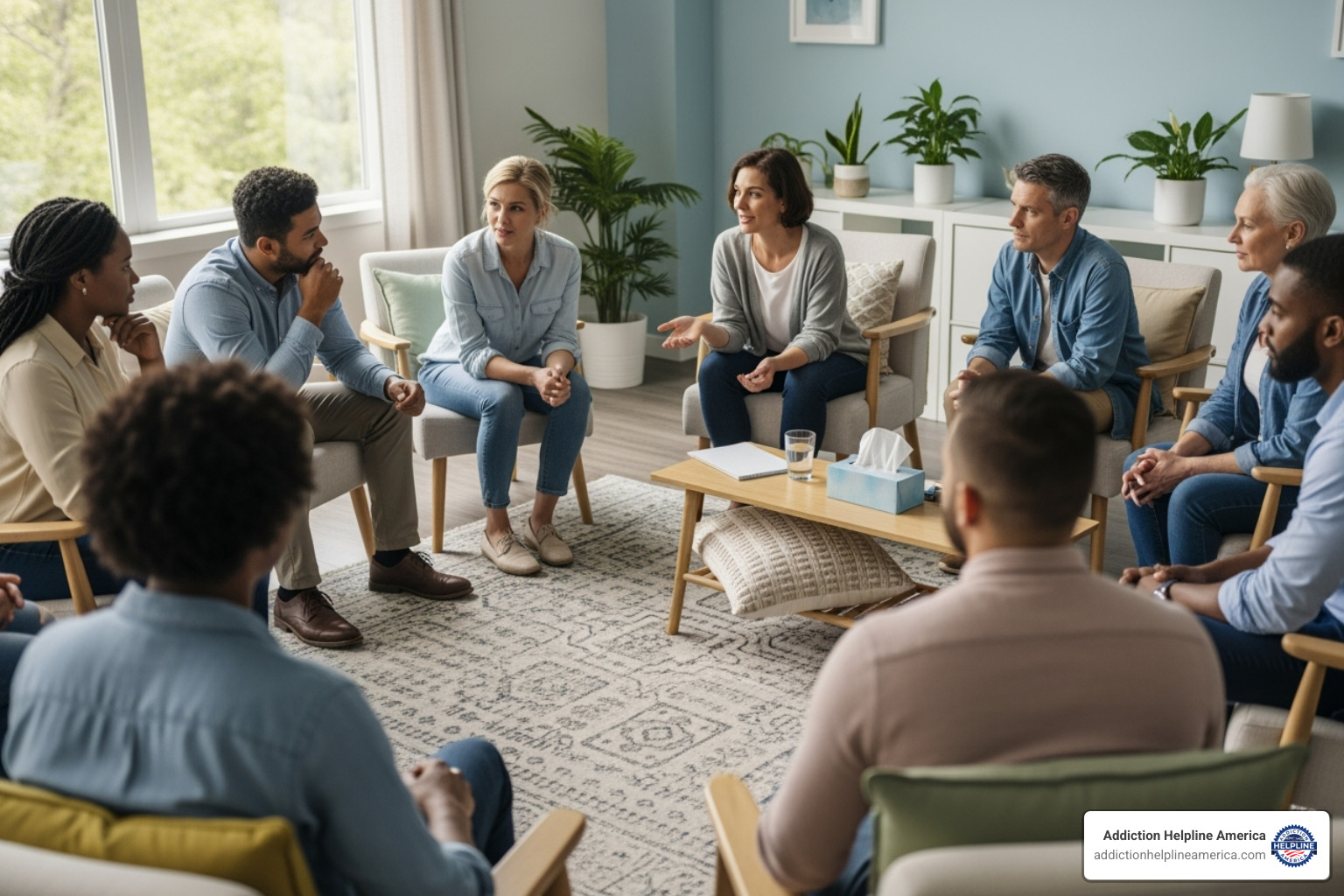Your Journey to a Healthier Life Starts Here
Free Insurance Verification
Verify Your Treatment Coverage
Verify Your Treatment Coverage

Opiate Addiction Treatment Centers provide specialized medical and psychological care to help individuals overcome opioid use disorder. By using evidence-based treatments, these centers address both the physical and psychological aspects of addiction.
Main Types of Treatment Centers:
Opioid addiction is a medical condition that hijacks the brain’s reward system, creating powerful physical dependence. Withdrawal symptoms like muscle aches, nausea, and intense cravings make quitting alone extremely difficult. The U.S. saw over 68,600 opioid overdose deaths in 2020 alone, but here’s the critical truth: effective treatment exists, and recovery is possible.
The most effective programs combine Medication-Assisted Treatment (MAT) with counseling. This approach reduces cravings and withdrawal, helping you develop coping skills and address underlying issues. Research shows MAT significantly decreases the risk of relapse and overdose.
The path to recovery typically involves several phases:
Cost shouldn’t be a barrier to getting help. Most insurance plans cover addiction treatment, and many centers offer payment plans or financial assistance.
At Addiction Helpline America, we connect individuals with the right opiate addiction treatment centers for their unique situations. Choosing a center is a major decision, and our team is here to provide compassionate guidance, helping you steer your options with confidence.

Recognizing the need for help is the first step on the recovery journey. Opioid Use Disorder (OUD) is a chronic medical condition, not a moral failing. Opioids rewire the brain’s reward system, creating powerful cravings and physical dependence that make it feel impossible to stop without professional support. The rise in overdose deaths underscores why early recognition and intervention at Opiate Addiction Treatment Centers are life-saving.
People struggling with opioid addiction often try to hide it, but there are common signs across three categories: physical, behavioral, and psychological.
To be formally diagnosed with Opioid Use Disorder (OUD), a person must meet specific criteria. However, if opioid use is causing problems in any area of life, it’s time to seek help.
Quitting opioids alone is incredibly difficult because withdrawal symptoms can be severe. This is a physical response as the body adjusts to the absence of a substance it has come to depend on.
Withdrawal typically begins within 12-30 hours of the last dose. Symptoms can feel like a severe flu combined with intense psychological distress.
This combination of physical and mental anguish is why professional support is crucial. The withdrawal timeline varies based on the opioid used, but symptoms for short-acting opioids like heroin typically peak in 1-3 days and improve over a week. While rarely life-threatening, the severe discomfort often drives people back to using, increasing their overdose risk. Medically supervised detoxification at a treatment center makes this process safer and more manageable.
Opiate Addiction Treatment Centers offer a range of programs on a continuum of care, ensuring you get the right level of support for your needs. This flexible approach recognizes that recovery isn’t one-size-fits-all. The main options include medical detox, inpatient/residential treatment, and various levels of outpatient care, including virtual programs.
Many people move through different levels of care as they progress, perhaps starting with inpatient treatment and transitioning to an outpatient program. This stepped approach provides structure when it’s most needed and helps you gradually reintegrate recovery into daily life.
Here’s how inpatient and outpatient options compare:
| Feature | Inpatient Rehab | Outpatient Rehab |
|---|---|---|
| Key Features | 24/7 medical supervision, highly structured environment, removal from triggers | Flexible scheduling, maintain work/family life, various intensity levels (PHP, IOP, standard) |
| Best For Whom | Severe addiction, unstable home environment, co-occurring mental health issues, detox | Moderate addiction, strong home support, step-down from inpatient, virtual options for accessibility |
| Duration | Typically 28–90 days, can be longer based on individual needs (~4 weeks on average) | Varies: PHP (20+ hrs/week), IOP (9+ hrs/week), standard (1–2 hrs/week); can last months to a year |
| Intensity | High: daily therapy, group sessions, medical care, structured activities | Moderate to low: regular therapy sessions, less immersive, requires self-discipline and external support |
Residential or inpatient care means you live at the facility, allowing you to focus entirely on getting better. It’s the most intensive option and is ideal for those with severe addiction or an unsupportive home environment.
Key benefits include 24/7 medical supervision to manage withdrawal and other health concerns, a structured schedule of therapy and activities to build healthy routines, and intensive therapy to address the root causes of addiction. You also gain powerful peer support from others on a similar journey. Most importantly, inpatient care removes you from daily triggers and stressors, creating a safe space to heal. Programs typically last about four weeks, but longer stays are available based on individual needs.

Take the first step towards a healthier life! Call now to connect with our compassionate team and start your recovery journey today. Your path to healing awaits!
Our recovery specialists are available 24/7 to provide support, and all calls are confidential and free. Reach out anytime – we’re here to help!
Outpatient treatment allows you to live at home and attend scheduled therapy sessions, making it a practical choice if you have work or family commitments. You learn recovery skills while navigating real-world situations
Outpatient care is offered at different intensities:
Many centers now offer same-day access to start treatment immediately. The growth of virtual care options has also made quality treatment more accessible and convenient than ever, delivering therapy through video sessions. For more information, explore Addiction Helpline America’s outpatient services.
Quality Opiate Addiction Treatment Centers use treatments backed by science. The cornerstone of modern care is Medication-Assisted Treatment (MAT), which recognizes that opiate addiction is a medical condition that changes brain chemistry. MAT combines FDA-approved medications with counseling and behavioral therapies to treat the whole person.
The medications address physical dependence and cravings, giving you the stability to engage in therapy and rebuild your life. People receiving MAT are far more likely to stay in treatment and avoid relapse or a fatal overdose. These treatments save lives and provide the foundation for long-term recovery.
Opioid Agonist Therapy (OAT) uses prescribed medications that act on the same brain receptors as illicit opioids but in a controlled, therapeutic way. They reduce cravings, ease withdrawal, and block the euphoric effects of other opioids, providing stability instead of chaos.
Research consistently shows that OAT dramatically decreases the risk of relapse and overdose. It also reduces all-cause mortality, meaning patients live longer, healthier lives. For more details, the CDC provides helpful information on opioid terms
Detox is the process of safely clearing opioids from your body while managing withdrawal symptoms. It is a necessary first step, but it is not a cure for addiction. The real work of recovery begins after detox is complete.
Attempting to detox on your own can be miserable and lead to relapse. Medically supervised withdrawal in a professional detox setting is crucial. Healthcare providers monitor you 24/7 and provide medications to ease discomfort, reduce anxiety, and ensure your safety. This supportive environment increases the likelihood that you will complete detox and transition into a comprehensive treatment program.
Following detox, some individuals begin naltrexone therapy. Naltrexone is an opioid antagonist that blocks opioid receptors, preventing any opioid from producing an effect. Available as a daily pill or a monthly injection (Vivitrol), it can be an effective tool for preventing relapse.

While medication stabilizes the body, therapy and holistic support are essential for healing the mind and building a new life. Opiate Addiction Treatment Centers provide the tools to understand the root causes of addiction, develop healthy coping mechanisms, and create a life worth protecting.
Counseling provides a toolkit for navigating life without opioids. Common evidence-based approaches include:
Many people with opiate addiction also have co-occurring disorders like depression or anxiety. Effective treatment addresses both the addiction and the mental health condition simultaneously, which is crucial for lasting recovery.
Recovery Capital refers to the total resources—personal, social, and community—that support your recovery. The more capital you have, the better equipped you are to handle challenges. Treatment centers help you build this capital through:
Harm reduction is a practical, non-judgmental approach that aims to keep people safe. This includes providing naloxone kits to reverse overdoses and education on safer practices. By reducing the negative consequences of drug use, harm reduction keeps people alive and connected to care, providing a pathway to recovery when they are ready.

There is no one-size-fits-all solution for opiate addiction. The best programs offer personalized treatment that addresses your unique life circumstances, background, and needs.

Take the first step towards a healthier life! Call now to connect with our compassionate team and start your recovery journey today. Your path to healing awaits!
Our recovery specialists are available 24/7 to provide support, and all calls are confidential and free. Reach out anytime – we’re here to help!
There is no one-size-fits-all solution for opiate addiction. The best programs offer personalized treatment that addresses your unique life circumstances, background, and needs.
The best Opiate Addiction Treatment Centers offer specialized tracks for specific populations, creating a more effective and supportive environment.
When evaluating a center, ask about their treatment philosophy, staff qualifications, program length, aftercare support, and licensing and accreditation. These details are key to finding a program where you feel safe and understood.
Cost should never be the barrier that prevents you from getting help. There are many options available.
Understanding your insurance benefits can be challenging. At Addiction Helpline America, we can verify your coverage and explain your benefits at no cost to you. The long-term cost of addiction far outweighs the cost of treatment.
While online directories and helplines can be useful, navigating these options alone can be overwhelming. This is why Addiction Helpline America exists. We offer free, confidential, personalized guidance to connect you with the right program from our vast network. We match you with a facility that fits your clinical and financial needs.
Don’t figure this out on your own. Reach out to Addiction Helpline America today—we’re here to help you take that first courageous step.
It’s natural to have questions when considering treatment. Here are answers to some of the most common inquiries we receive.
Treatment duration is highly individualized. While some programs are 28-30 days, research shows that at least 90 days in treatment provides the best outcomes. The length depends on the level of care:
The ideal length is customized to your addiction severity, co-occurring conditions, and personal progress. Committing to the recommended duration builds a strong foundation for sobriety.
Opiate addiction treatment is highly effective, especially when using Medication-Assisted Treatment (MAT). Medications like methadone and buprenorphine significantly reduce relapse and overdose risk. Success isn’t just about abstinence; it’s about improved health, well-being, and functioning in daily life.
Aftercare is critical for long-term success. Ongoing counseling and peer support groups are associated with better outcomes.
Relapse can be part of the recovery process. It does not mean treatment has failed. Instead, it’s a sign that the treatment plan may need to be adjusted. Many people who experience a relapse go on to achieve lasting sobriety. With a comprehensive, individualized plan, long-term recovery is absolutely possible.
Rapid detox, often done under anesthesia, aims to speed up the physical withdrawal process. While it can offer a faster, more comfortable withdrawal, it is not a standalone cure.
For rapid detox to be effective, it must be immediately followed by comprehensive aftercare, including therapy and relapse prevention medication like Naltrexone. Without this follow-up, the risk of relapse is extremely high. It is one of several detox options to consider as part of a broader recovery plan.
Taking the first step toward overcoming opiate addiction can feel daunting, but hope for recovery is a reality for thousands of people every day. There is no single path that works for everyone, which is why personalized care is essential.
Finding the right Opiate Addiction Treatment Center means finding a program that sees you as a whole person, not a diagnosis. It means connecting with professionals who will design a treatment plan that fits your unique life, goals, and needs.
This is where we come in. At Addiction Helpline America, we are your dedicated partners in this journey. We offer free, confidential, and personalized guidance, connecting individuals nationwide to our vast network of addiction and mental health treatment centers.
Whether you’re worried about cost, unsure what level of care you need, or simply don’t know where to start, we will walk alongside you. We help you verify insurance, explore payment options, and find a program that gives you the best chance at lasting recovery.
You don’t have to do this alone. Your path to recovery starts with a single, courageous step—reaching out for help. When you take that step, we’ll be there to guide you.
Learn more about how we can help you find the right treatment program.
Are you or a loved one struggling with addiction? Call today to speak to a treatment expert.
Calls to any general helpline will be answered or returned by one of the treatment providers listed, each of which is a paid advertiser:
Our helpline is available 24 hours a day, 7 days a week at no cost to you and with no obligation for you to enter into treatment. We are committed to providing support and guidance whenever you need it.
In some cases, Addiction Helpline America charges our verified partner a modest cost per call. This fee helps us cover the costs of building and maintaining our website, ensuring that we can continue to offer this valuable service to those in need.
Calls to the general helpline will be answered or returned by one of the listed treatment providers, all of whom are paid advertisers.
By using the helpline, you agree to the terms of use. We do not earn any commission or fee based on the treatment provider selected by the caller, and there is no obligation to pursue treatment.
This service is not affiliated with Alcoholics Anonymous World Services, Inc.